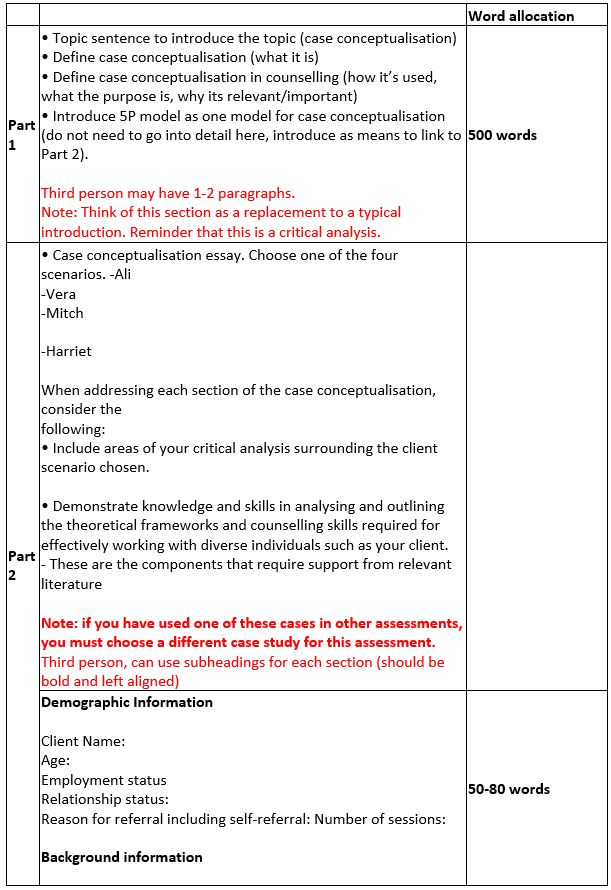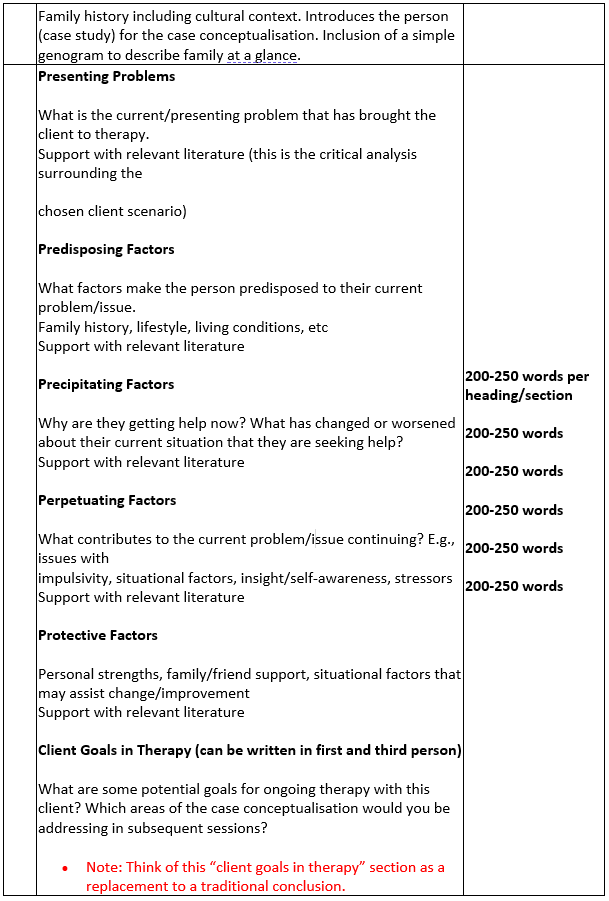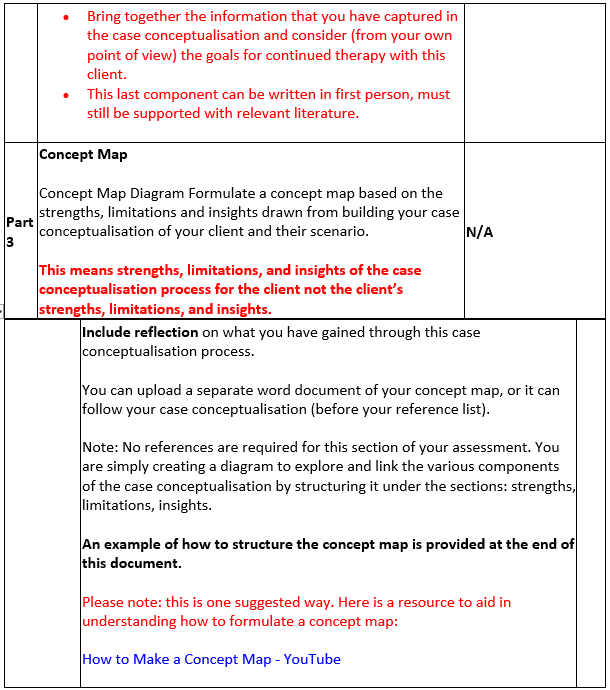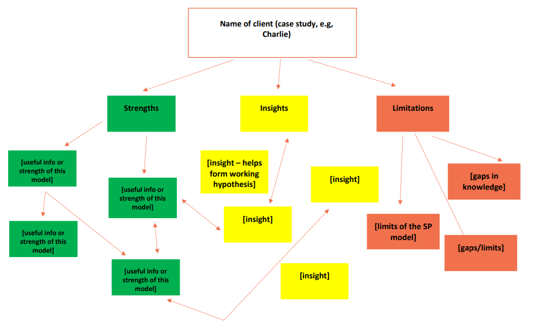Case Conceptualisation Assignment Using the 5Ps Model
Assessment Details and Instructions
Purpose:
The purpose of this assessment task is for students to develop a case formulation/conceptualisation for a given case study scenario client with a unique worldview shaped by various cultural experiences.
Use the 5Ps model as a framework to build your case conceptualisation.
Process to follow:
To complete this task, students will need to complete three parts:
1. Part 1. Define case conceptualisation and case conceptualisation in Counselling 500 words
2. Part 2. Using the 5P model, as a framework, develop a case conceptualisation foroneof the four scenario clients included in this Unit Outline (use a MS Word document -1200 to 1500 words)
3. Part 3. Formulate a concept map diagram based on the strengths, limitations and insights drawn from building your case conceptualisation of your client and their particular scenario. Include reflections on what you have gained through this client case conceptualisation process (use a MS Word document This can be a separate file upload)
Select one scenario only.
Scenario Clients
1. Ali
Ali, a 31-year-old support worker, relocated to the Western suburbs of Sydney from Pakistan four years ago with his wife Sana. 18 months ago, Ali and Sana had their first child, Naveed. Ali has various roles as a husband, father, support worker, and full-time student pursuing a bachelors degree in nursing, Ali's life has become increasingly demanding. Ali and Sana are navigating the cultural landscape within Australia and how to share meaningful connections to their homeland with their son, Naveed.
Ali and Sana often talk about feeling physically and mentally drained from both working shiftwork and looking after Naveed.
Although Ali initially enjoyed his job and studies, he now finds it challenging to complete his coursework due to the added responsibilities of caring for a young child. Financial constraints of only being able to work 20 hours per week (as part of his student Visa requirements) have added additional pressure on Ali. As a result, Ali's physical and emotional health has suffered. He has become snappy, irritable, exhausted, and unmotivated both at home and work.
Ali has noticed a strain in his relationship with Sana, feeling resentful when asked to contribute to household chores. He has started questioning his commitment to completing his studies and even his desire to remain in the marriage. These emotions have led him to feel unloved and taken for granted. Ali often calls home and speaks with his parents and his younger Brother. Ali told his brother, Khaan about his negative thoughts and attitudes about work and home and that he does not want to feel this way.
A colleague at Alis work suggested that maybe he should go see his GP as Ali does not appear to be his usual self. Ali reported that he has been experiencing headaches at night and in the morning. After attending the GP, all his results ruled out any physical health concerns and his doctor suggested that his symptoms might be due to stress.
2. Vera
Vera is a 65-year-old woman who recently retired from her teaching career. Vera is currently residing in regional Victoria. Vera was a secondary teacher who taught English and Geography for over 30 years. Vera was a much-loved teacher and dedicated many years to supporting her students. Vera was eager to embark on retirement and to be able to enjoy quality time with her husband of 40 years, Jamie, and their two adult children, Sean (34) and Emily (31), and her 3-year-old Granddaughter, Lili.
After retiring, Vera began to experience severe anxiety, particularly in social situations. Vera began to avoid leaving the house and declined invitations from her friends and previous colleagues to meet socially. Vera had previously been an active member of her local community garden. Vera stated that she is currently experiencing bouts of emotional distress for example feeling teary, racing heart, and somatic complaints. This can occur for Vera when she is attempting routine tasks such as general housework and gardening.
Vera stated that Jamie was becoming increasingly worried for her. Jamie is unsure if they should continue to plan overseas trips as part of their retirement if Vera is not able to leave the house.
Vera has shared that her childhood was marked with feelings of being undervalued and overshadowed by her older brother. Her parents had initially expressed a preference for a son, and she vividly recalls the feeling of being unwanted. One memory that stands out to her is when she returned home from school to an empty house, and her mother arrived home many hours later, wondering why she was crying and to be more concerned with the state of the house than her feelings. When her parents passed, Veras brother inherited everything, a decision that she did not question.
3. Mitch
Mitch is a 21-year-old Aboriginal man residing in Meanjin. As part of Mitchs probation conditions, he is mandated to take part in substance use counselling.
At 13, Mitch began to experiment with Cannabis and alcohol and at 15 began to socially smoke methamphetamine. As his substance use escalated, this led to frequent encounters with the law. Growing up, Mitch stated that his home environment was not always safe as his parents had issues with alcohol. Mitch and his sister would often spend more time at his aunts house or at friends houses. Mitch reported that some of his best memories growing up was playing AFL at school and for a local club that was down the street from his aunts house.
From 16 to 21, Mitch has been in and out of incarceration, and his crimes are primarily related to substance use such as possession, theft, and drug-related offences. Each time he is released from incarceration, he struggles to reintegrate into society due to limited employment opportunities and a lack of supportive networks.
Upon his most recent release, Mitchs community corrections officer supported him to find labouring work with a local building company. Mitch has stated that he is looking forward to work however is afraid it will just be like all the other times. Mitch was released two weeks ago and has begun to use Cannabis. Mitch is currently residing with his Aunty who can take him to and from work as he does not currently have his license. Mitch also lives with his 18-year-old Sister, Ashleigh, and his 10-year-old cousin, Ben. Ben and Mitch often play video games together. Mitch reported that he wants to be a good role model to Ashleigh and Ben. Mitch stated that he loves making music on his aunts computer and wants to get back into AFL training.
Mitch did not make it to his first shift. Mitch stated that he has difficulty getting out of bed. He feels that everyone will know he has been to prison which will make his life difficult.
4. Harriet
Harriet is a 45-year-old Transgender woman. Harriet was referred to counselling by Police following a recent incident. Two weeks ago, Harriet was awoken by loud yelling coming from the footpath outside her apartment. Harriet discovered that a group of people including two of her neighbours were directing offensive and derogatory slurs at her.
The situation escalated when one of her neighbours brought out a hammer and walked toward her car. Harriet called the Police and they arrived at her apartment in 5 minutes.
Since the incident, she has had difficulty sleeping and has become hypervigilant when leaving her home. Harriets parents (Peter and Emma) have offered for her to stay with them however they live one hour away. Harriets father calls when she is driving home from work to make sure she gets into her apartment with no issues. Harriet feels unsafe in her home however due to rental scarcity she is having difficulty finding a new place.
Harriet stated that growing up in a rural town, she did experience slurs and stares. Harriet reported that her two older Sisters would often protect her at school. Harriet reported that she would often find solace at her grandmothers house. Harriet reported that her grandmother was her biggest supporter, especially during her transition. Harriets grandmother, June would often drive her one hour out of town to the hospital for her hormone replacement therapy. June passed away two years ago which has been difficult for the whole family.
Assignment Criteria
Process to follow:
Part 1
Define case conceptualisation and case conceptualisation in Counselling (500 words)
Part 2
Case Conceptualisation
Using the 5P model as a framework to develop a case conceptualisation for one of the 4 scenario clients included in this Unit Outline. (use a MS Word document 1200 to 1500 words)
Choose one of the case studies supplied here, as your client.
Include areas of your critical analysis surrounding the client scenario chosen.
Demonstrate knowledge and skills in analysing and outlining the theoretical frameworks and counselling skills required for effectively working with diverse individuals such as your client.
The following template can be used to structure this part of the assessment.
Demographic Information
Client Name.
Age:
Employment status
Relationship status:
Reason for referral including self-referral:
Number of sessions:
Background Information
Family history including cultural context:This is an introduction to your essay for Part 2. Include a simple Genogram describing the family at a glance.
Presenting Problems
Drug Use and Risk Assessment: For example -Any polydrug use and where smoking fits into lifestyle; Any suicidal ideation and ongoing risk management plan with other services; Any risk of harm to others during psychotic episodes etc.)
Motivation to Change: What brought client to counselling? What is the client prepared to work on? What is the client not willing to work on? What are the client's long-term goals?
Predisposing Factors
For example - Lifestyle history of poor coping skills, high sensitivity to stress etc. Employment status, living conditions, social isolation etc.
Precipitating Factors
Why do they want help NOW? Any recent changes in their lives vocationally, interpersonally, physically or psychiatrically?
Perpetuating Factors
E.g. issues with impulsivity, cognitive insight and psychological mindedness, situational factors such as friends or family members who smoke, identified factors contributing to past relapses etc.
Protective Factors
Friends or family members who are supportive of them making changes, personal strengths, situational factors that may assist change process such as moving to a new house, getting a new job etc.
Client Goals in Therapy:
Eg: As a conclusion write a summation of the client case conceptualisation including your view on goals for continued therapy for your client.
References:Include Reference list (APA7) and in-text references in your case Conceptualisation essay.
Part 3
Formulate a concept map diagram based on the strengths, limitations and insights drawn from building your case conceptualisation of your client and their particular scenario. Include reflections on what you have gained through this client case conceptualisation process (use a MS Word document This can be a separate file upload)
SCAFFOLD





Are you struggling to keep up with the demands of your academic journey? Don't worry, we've got your back!
Exam Question Bank is your trusted partner in achieving academic excellence for all kind of technical and non-technical subjects. Our comprehensive range of academic services is designed to cater to students at every level. Whether you're a high school student, a college undergraduate, or pursuing advanced studies, we have the expertise and resources to support you.

